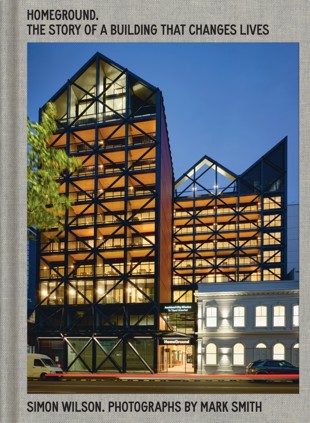John Daly-Peoples has reviewed HomeGround: The story of a building that changes lives by Simon Wilson.
‘For many years the crowds milling outside the Auckland City Mission on Albert St was one of the obvious signs of the housing and homelessness crisis affecting the country. They were a stark reminder that New Zealand had one of the highest levels of homelessness in the OECD.
But this year has seen the start of what many hope will be a radical change in the way the country addresses the issue of homelessness. The Auckland City Mission opened HomeGround a new multi-story development which directly addresses the problem providing accommodation and support services for eighty residents.
Those who experiences homelessness and living in poverty are normally never able to access affordable housing. This experience may result from loss of a job and income, sickness or short-term disability, needing to leave their home due to violence. For some this will be a temporary period in their lives but others may have a number of these episodes over their lifetime.
There are a number of ways that permanent supportive housing can be created and managed but the major way is the ‘high density’ models such as HomeGround which involves people living in one apartment complex, with some of the support services they need to sustain their tenancies provided on-site.
The new building designed by Stevens Lawson Architects has 80 residential units each with their own kitchen and bathroom. The complex also has extensive support elements — a detox centre, medical centre, food bank, a roof top terrace as well as several lounges and meeting rooms.
The genesis and development of the project has been documented in a new book “HomeGround, The Story of a building that changes lives” written largely by Simon Wilson.
It records the key steps and individuals that brought the building and the work done thereinto existence — a visionary social services agency, a committed architecture practice, courageous funders, and skilled construction specialists.
From the plans the building looks very much like a hotel with individual guest room and various facilities but the thinking behind it and the consultation around its design was very different. For HomeGround consultation was focused on the eventual inhabitants and their particular needs. What was being built was not just a building but a community and that was at the centre of the design thinking. While the building creates a village for the inhabitants it has been designed as a part of the wider community and there is a walkway which allows members of the public to move from one street to another through the complex so they connect with the inhabitants rather than merely passing by.
The acknowledgement of the inhabitants is central to the book and Simon Wilson includes a section where he has interviewed two of the residents who talk of their depressing and harrowing lives which have brought them to this place, through bad parenting, ill health, drug taking, social isolation. HomeGround offers a retreat, a new beginning, possibly even a paradise.
Simon Wilson has written the book along with Professor Deidre Brown and Dr Karamia Muller and there is a foreword by Richard Didsbury. Photographer Mark Smith has photographed the building as though for an architectural publication but has also documented the people who have made the building possible as well as the people who live there and the people who work there.
The book weaves together the various threads of creative architecture and planning acute social problems along with the power of individuals and organisations to effect social change.
Simon Wilson is one of New Zealand’s best-known journalists. The former editor of Cuisine and Metro magazines and Auckland editor for The Spinoff, he is now a senior writer at The New Zealand Herald. He is a regular writer on urban and social issues.
Professor Deidre Brown (Ngāpuhi, Ngāti Kahu) is an art historian and architectural lecturer. She is head of the School of Architecture and Planning at the University of Auckland and a governor of the Arts Foundation of New Zealand. Dr Karamia Muller is a Pacific academic who lectures at the School of Architecture and Planning at the University of Auckland. Her research specialises in the meaningful ‘indigenisation’ of creative practices and design methodologies invested in building futures resistant to inequality.’
To read the extract selected here.


